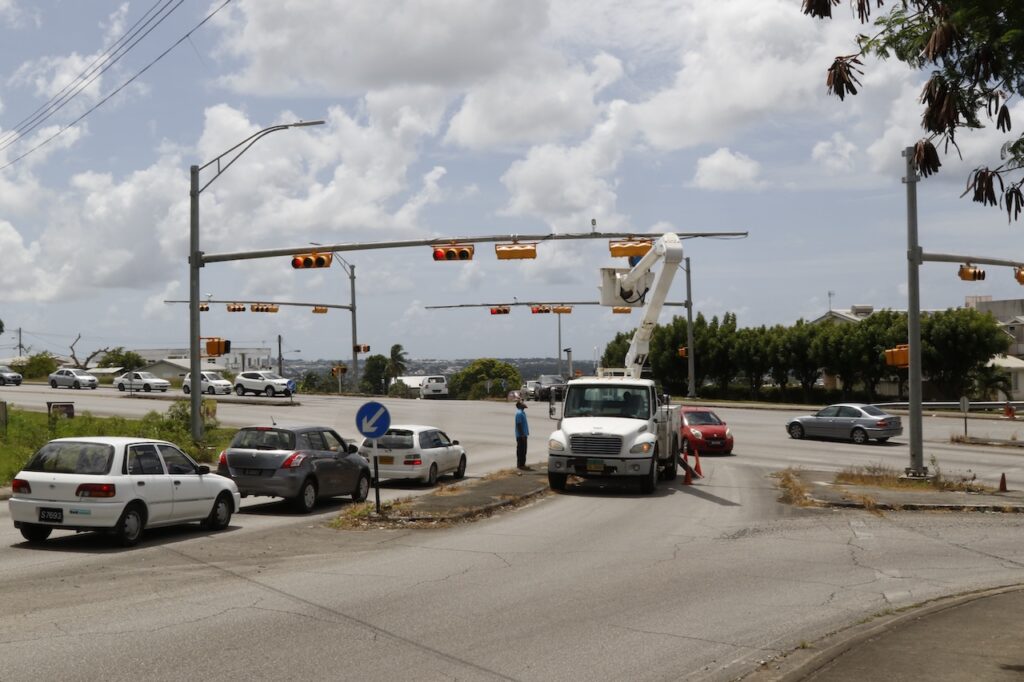After being out of commission for over a year, the life-saving hyperbaric chamber at the Barbados Defence Force is being put back into service.
The training and recertification came in the form of a one-week diving medicine training course being held by the BDF and Canadian Armed Forces with support from the Canadian High Commission.
The training is designed to enhance the hyperbaric chamber drive capability and capacity of Defence Force sailors to treat diving-related injuries. The BDF is the home of one of the very few hyperbaric chambers in the region. The chamber, a sealed vessel where oxygen is delivered at higher-than-normal levels of atmospheric pressure, is used for hyperbaric oxygen therapy (HBOT) to treat decompression sickness, air embolisms, carbon monoxide poisoning, crush injuries, necrosis, thermal burns, anaemia, and diabetic wounds.
Commander Michael Montague, a command surgeon with the Canadian Joint Operations Command and one of the trainers, said the assistance from the Canadian forces was sought because of Canada’s “robust” for training technicians and clinicians to manage injuries and distress in divers.
The annual Tradewinds 24 regional military training exercises later this year would provide an “excellent” opportunity for Canadian divers to examine the available resources in the region to treat a diver in distress, he said. “One of the treatments that could be required is hyperbaric medicine. Fortunately, the BDF has had a hyperbaric medicine chamber since the early 80s as I understand, and they have treated many Canadian divers in the past.
“There was a reduction in the usage of the chamber. And now’s an opportunity to get the team back together from the BDF to be able to go through tactics and procedures to treat a stricken diver. And so having our dive specialists come down, we’re able to exchange information on what we do in Canada, how we train our Canadian Armed Forces members, and the procedures that we use to treat dive casualties and to provide the opportunity to get the entire team together at the BDF to run through scenarios and to get the team working together again after a period where the chamber wasn’t being used.”.
Discussing the recertification process, he highlighted the involvement of multiple agencies, including clinicians and engineers to ensure the proper functioning of the chamber’s systems and assessing the team’s competencies are crucial components of the recertification process.
The Canadian team of three clinicians and a technician has been actively engaged in this comprehensive evaluation, said Commander Montague. In his assessment of the BDF team’s readiness, he praised their strong clinical capabilities and organisation.
“It just seems to be little things,” he added. “It’s reminding people to think of a little broader differential diagnosis when it comes to the stricken diver and to ask those questions about diving history that are important.
“I believe that the team is very well organised. And the clinical capabilities are second to none. It’s just getting that team building process together that we achieve by doing this training over this week.”
Another trainer, retired Major David Binks, a senior operator and safety officer of the chamber, told reporters that extensive efforts were put into maintaining and upgrading the crucial equipment, highlighting the meticulous care it receives. He noted an assessment by the not-for-profit Divers Alert Network (DAN) that the BDF chamber was deemed to be in excellent condition, requiring minimal intervention.
A grouping of dive safety charities, DAN was founded in the United States at Duke University in North Carolina, at first providing a 24-hour diving medical helpline.
Major Binks explained: “The DAN – Divers Alert Network form states that the chamber was in excellent condition and didn’t need anything done. We look after it. We know it’s expensive. We know that it’s there to save somebody’s life. We look after it and make sure it’s always ready to go barring anything major occurring.
“The old one stopped working, I think it was late 2022, early 2023. . . the process we had to go through to get a replacement . . . that is the government so . . . we got the first chamber at the end of 1983 and first used it on the fourth of July, 1984 . . . we had to do all the training and stuff first. It wasn’t just a case of ‘it comes here and we start using it.
Discussing the ongoing training with the Canadian Armed Forces, he outlined that the specialists were providing training for new staff, including doctors from the Accident & Emergency Department and the BDF.
“We have a new BDF doctor, we have other staff and they have come to run a chamber course,” said Major Binks. “We would either go up to the ‘States . . . to send a couple of people to the states to do this course or we would try and get somebody come down to do it and the Canadian government has said that they were willing to send their training people down to run the training course for our new staff.
”Overall, we go through training programmes, we go through refresher training programmes. I have some new engineers working with me. I have one engineer that has worked with me before so he’s doing refresher training, and I’m training the other engineers. We need to get more people in both engineers, tenders and operators, but we go through a rigorous training programme to make sure that everybody is up to speed,” he further explained.
(RG)
The post Crucial air pressure chamber ‘getting back in action’ appeared first on Barbados Today.


